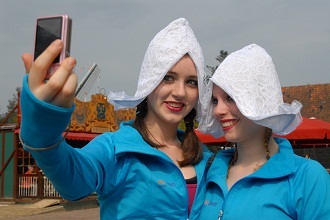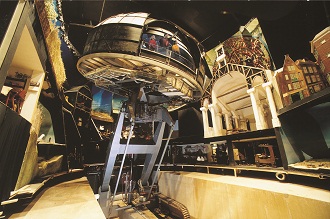
In November last year, the Netherlands Open Air Museum was awarded the prestigious BankGiro Lottery Museum Prize 2009. We received euro;100.000 from which we can spend 25% freely and 75% in close consultation with the Prins Bernard Cultuurfonds. Together we agreed on spending this euro; 75.000 on producing specialized educational products for children with mental and physical drawbacks. With these products we enable them to experience the museum in a more effective way. We want to open up their own world of memories, to stimulate them to investigate their own cultural heritage of personal and quite often emotional past. But this is not the project the Museum prize was awarded; this is what the money enabled us to do: to make a cherished wish come true. To invite a new audience to our world of cultural heritage.
Ladies and gentlemen, here I want to dwell on three issues. The first will be the BankGiro Lottery Museum Prize in itself. Then I will try to define the more general effect exercised by this Prize in the public domain, related to the dissemination of the support for and interest in cultural heritage. A theme related to the question of marketing. Finally, I want to share a dilemma with you: because it keeps me out of sleep already for weeks and because it is an apt theme for further discussion.
1. The Netherlands Open Air Museum didn't receive the mentioned prize for a specific project. It is a price connected with the overall performance of this museum. Not judged by a small group of experts, but by the public. What makes this award different from many others is the active participation of the public in the final judging process. After 5 museums were preselected by a board of professionals, it was the public who voted by email and sms for ls"the museum that presents history in the most successful way.' This was the theme chosen by the organizing committee in 2009: history. As the committee wrote: ls"the nominees were the five museums that make [a period in] Dutch History accessible to a wide public most successfully.'
Out of 5 -in my opinion: all equal in quality and importance!- the Netherlands Open Air Museum was chosen by the public, with 30 % of the votes. More than 52.000 people participated.
Why this museum? Because it has many visitors, last year nearly 500.000 who we asked, during the period of voting to vote for us? Because of its many, many registered friends of our museum: 13.000 who we invited to vote for us? In short: a battle that we had to win, just because of our national position? Well, although a victory seemed within reach, it wasn't that easy. Thank God, because, in my opinion here lies the instrumental quality of this prize: it made the public think and aware. I will come back to this. I can tell you that it was a very nice competition, fuelled by the BankGiro and Prins Bernard Foundation weekly. Every Monday, during the months September-October, they published the result of the votes.
Afterwards we did our after sales. Why did you vote for our museum? Out of these answers I want to take one: quite often we heard that it was appreciated that this museum not just put cultural heritage on show but used it to stimulate discussions and talks between the visitors. Even more: to open up in the minds of the visitors unknown horizons of partially forgotten memories. They were, in short, moved. They felt themselves and their stories taken very seriously, as the main theme of the museum. We use our objects to excavate the immaterial heritage of our visitors. This mutual process was valued highly. But will our visitors vote again in favour of our museum if we are going to discuss with theme more complex questions? If we are going to show them the bullet that killed William of Orange, the Khanjar or knife that killed Theo van Gogh?
You may know the Netherlands Open Air Museum, founded in 1912. Because it was transformed by my predecessor Jan Vaessen from a traditional open air museum into a place were ls"stories, feelings and experiences are shared by the public' for which he was awarded in 2005 with the European Museum of the Year Award. With new presentations focused on post-war themes: from feel good themes like ls"the seventies' to questions as decolonisation. He put on show the wooden barn, erected in 1938 in the province of Brabant, in which initially were housed workers form Rotterdam, then, from 1941 onwards, Dutch men and women captivated by the Gestapo and finally, from 1951 inhabitants of the Moluccan islands, Indonesian Archipel. In this camp barn, we show a picture that to my generation is more familiar than the Nightwatch: the train, hijacked by a small group of Moluccan men in 1976. Believe me, this presentation is compelling.

2. Now back to the prize. Although very much welcome, it is not the money that is, in my opinion, what makes this Prize interesting. No, its real merit is in the debate and discussion it aroused within the public domain. No, our friends and visitors didn't just vote for our museum. I thought, they would do. That they just would listen to our very wise advice. No. What many of them did was taking a closer look at what the selected museums had to offer. They made up their mind: which theme was relevant to them? That of the Royal Tropenmuseum in Amsterdam? Or that of the Dolhuys in Haarlem, focusing on the world of people with mental shortcomings? The prize made them fully aware of the thematical diversity of the Dutch museums//museums worldwide, or, in general, of the world of cultural heritage -which not only included objects but also traditions. It made them aware that cultural heritage is not something isolated in a museum; it made them aware that they are part of that same heritage. Their traditions and habits as part of a whole. It made them aware that there are many methods and instruments of presenting cultural heritage. And finally the prize made them aware of the role they can play themselves in supporting cultural heritage. Shouldn't be the Prize itself becoming awarded as a very effective instrument in the strategy of connecting the public to cultural heritage?
3. Now I will come to a close. In 2012 the Netherlands Open Air Museum will celebrate its founded in 1912. A museum that is cherished by the Dutch as one of their symbols and main cultural institutions. A perfect synopsis of what we were, what we are and of what we will become? I don't know? Cherished by the Dutch. All Dutch? Here, finally, we have the main issue. Yes, this museum has won the public Prize because it is popular institution for nearly a century. And in the high public esteem, ls"our museum', lays the difficulty for further development. Will the public still cherish this museum as ls"typical Dutch', as ls"our museum' when it presents the Netherlands as it is today? When we continue the line of the Moluccan camp barrack with more very relevant but also very complex presentations. We did a job in post-war Holland in bringing together men and women of different provinces. Is it still our task to bring together different traditions and people? Or should we choose for a safe future, with presenting the Netherlands as it was, and as it should remain according to many? Will we win then, in, say 2025 again the Museum prize?